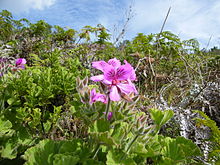
Pelargonium

Pelargonium /ˌpɛlɑːrˈɡoʊniəm/ is a genus of flowering plants which includes about 200 species of perennials, succulents, and shrubs, commonly known as geraniums, pelargoniums, or storksbills. Confusingly, Geranium is the botanical name (and also common name) of a separate genus of related plants. Both genera belong to the family Geraniaceae. Linnaeus originally included all the species in one genus, Geranium, and they were later separated into two genera by Charles L’Héritier in 1789. Pelargonium species are evergreen perennials indigenous to temperate and tropical regions of the world, with many species in southern Africa. They are drought and heat tolerant, but can tolerate only minor frosts. Some species are extremely popular garden plants, grown as houseplants and bedding plants in temperate regions.They have a long flowering period, with flowers mostly in purple, red and orange, or white. The name Pelargonium is derived from the Greek πελαργός, pelargós (stork), because the seed head looks like a stork's beak. Dillenius originally suggested the name 'stork', because Geranium was named after a crane — 'a πελαργός, ciconia, sicuti vocamus Gerania, γερανός, grus' (as pelargos, stork, as we call the Gerania, geranos, crane). Despite the Latin, this should not be confused with the modern-day genus Ciconia, of birds in the stork family. Pelargonium occurs in a large number of growth forms, including herbaceous annuals, shrubs, subshrubs, stem succulents and geophytes. The erect stems bear five-petaled flowers in umbel-like clusters, which are occasionally branched. Because not all flowers appear simultaneously but open from the centre outwards, this is a form of inflorescence is referred to as pseudoumbels. The flower has a single symmetry plane (zygomorphic), which distinguishes it from the Geranium flower, which has radial symmetry (actinomorphic). Thus the lower three (anterior) petals are differentiated from the upper two (posterior) petals. The posterior sepal is fused with the pedicel to form a hypanthium (nectary tube). The nectary tube varies from only a few millimeters, up to several centimeters, and is an important floral characteristic in morphological classification. Stamens vary from 2 to 7, and their number, position relative to staminodes, and curvature are used to identify individual species. There are five stigmata in the style. For the considerable diversity in flower morphology, see figure 1 of Röschenbleck et al. (2014) Leaves are usually alternate, and palmately lobed or pinnate, often on long stalks, and sometimes with light or dark patterns. The leaves of Pelargonium peltatum (Ivy-leaved Geranium), have a thick cuticle better adapting them for drought tolerance. Pelargonium is the second largest genus (after Geranium) within the Geraniaceae family, within which it is sister to the remaining genera of the family in its strict sense, Erodium, Geranium, and Monsonia including Sarcocaulon. The Geraniaceae have a number of genetic features unique amongst angiosperms, including highly rearranged plastid genomes differing in gene content, order and expansion of the inverted repeat. The name Pelargonium was first proposed by Dillenius in 1732, who described and illustrated seven species of geraniums from South Africa that are now classified as Pelargonium. Dillenius, who referred to these seven species with apparent unique characteristics as Geranium Africanum (African Geranium) suggested 'Possent ergo ii, quibus novi generis cupido est, ea, quorum flores inaequales vel et irrregulares sunt, Pelargonia vocare' (It would be possible therefore, if anyone wishes to make a new genus of which the flowers are unequal or irregular, to call them Pelargonia).The name was then formally introduced by Johannes Burman in 1738. However Carl Linnaeus who first formally described these plants in 1753 did not recognise Pelargonium and grouped together in the same genus (Geranium) the three similar genera Erodium, Geranium, and Pelargonium. Linnaeus' reputation prevented further differentiation for forty years. The eventual distinction between them was made by Charles L’Héritier based on the number of stamens or anthers, seven in the case of Pelargonium. In 1774, P. cordatum, P. crispum, P. quercifolium and P. radula were introduced, followed by P. capitatum in 1790.
